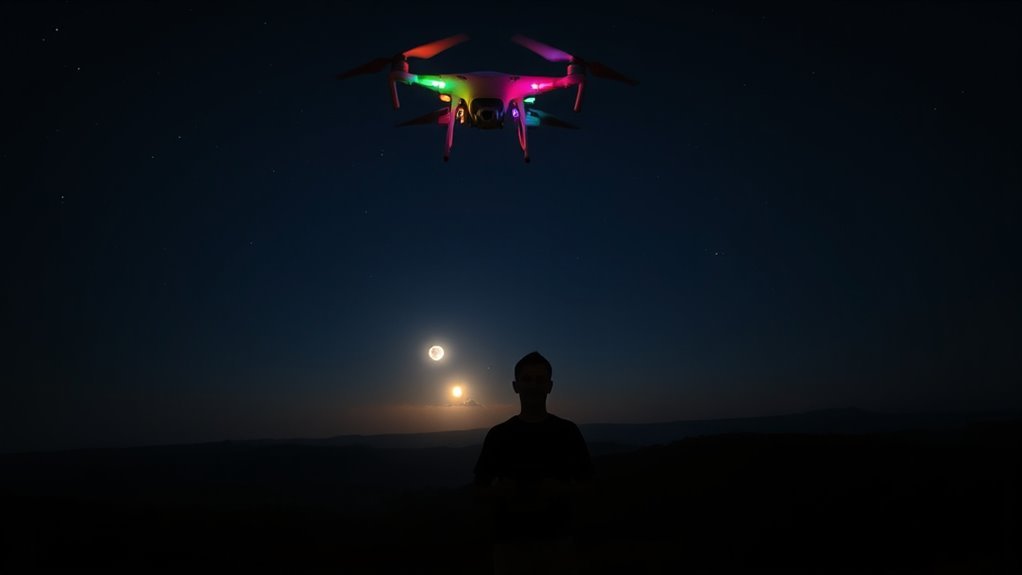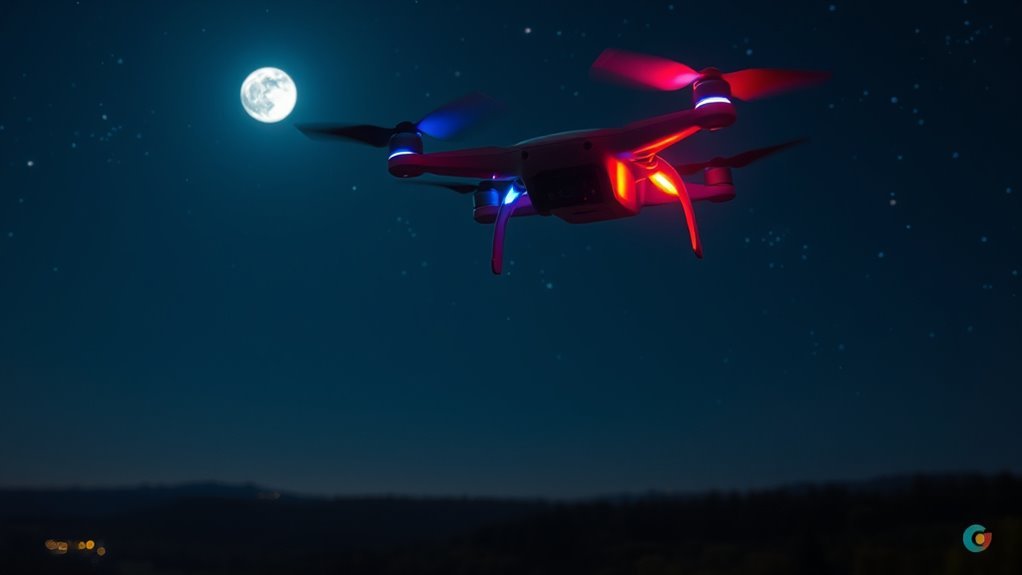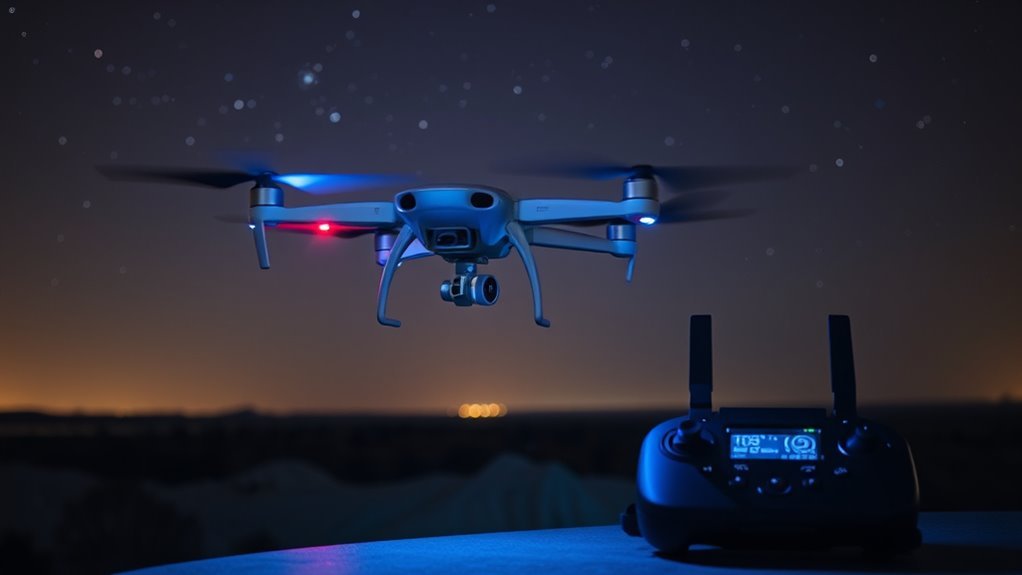To legally fly drones at night, you need to follow FAA regulations, which include obtaining a valid Remote Pilot Certificate and guaranteeing your drone is equipped with proper lighting and night vision capabilities. Keep your drone within visual line-of-sight and familiarize yourself with approved flight paths. It’s also important to have adequate insurance coverage that addresses nighttime operations. By taking these steps, you’ll guarantee safe and compliant flights, and there’s more to explore about best practices ahead.
Understanding FAA Regulations for Nighttime Drone Use

Although flying drones at night can offer unique opportunities for stunning aerial photography and exploration, it is crucial to understand the FAA regulations that govern such activities. To operate legally, you must make sure your drone is equipped with proper lighting for nighttime visibility. This helps both you and other airspace users maintain awareness of your drone’s position. Familiarize yourself with approved drone flightpaths in your area, as certain zones may restrict nighttime operations. Additionally, always keep your drone within visual line-of-sight, even in low-light conditions. By adhering to these regulations, you can enjoy the freedom of night flying while promoting safety and compliance. Remember, understanding these rules not only protects you but also respects the shared airspace.
Required Certifications for Night Flying

To legally fly your drone at night, you’ll need to obtain the proper certifications, as the FAA has set specific requirements to guarantee safety in low-light conditions. First, you must hold a valid Remote Pilot Certificate, which proves your drone pilot qualifications. After that, you’ll need to complete additional training to earn night flight certifications. This training focuses on understanding the unique challenges of flying at night, including navigation, visibility, and emergency procedures. You’ll also need to familiarize yourself with the specific operational limitations and regulations related to night flying. By ensuring you meet these requirements, you not only enhance your skills but also contribute to safer skies for everyone. Embrace your freedom, but do it responsibly!
Equipment Necessities for Safe Night Operations

Once you’ve secured the necessary certifications for night flying, equipping yourself with the right gear becomes crucial for safe operations. Fundamental equipment includes drones with night vision capabilities and thermal imaging features, which allow you to navigate and identify objects in low-light conditions. Additionally, Brinc’s thermal imaging can be particularly beneficial as it detects heat signatures, enhancing your ability to spot individuals or obstacles that may not be visible with traditional methods. Also, consider using additional lighting to illuminate your flight path and enhance visibility. Understanding signal attenuation is essential for ensuring that your drone maintains effective communication even in challenging environments.
| Equipment | Purpose | Importance |
|---|---|---|
| Night Vision Camera | Enhances visibility at night | Critical for safe flying |
| Thermal Imaging | Detects heat signatures | Essential for object recognition |
| LED Lights | Guides flight path | Essential for awareness |
| GPS System | Navigation | Guarantees safe return |
With the right gear, you can embrace the freedom of night flying safely.
Tips for Planning Your Night Flight
When planning your night flight, it’s essential to prioritize thorough preparation to guarantee a safe and enjoyable experience. Start by reviewing your flight planning meticulously, considering factors like location, weather, and airspace regulations. Confirm your drone is equipped with night vision capabilities, enhancing visibility and navigation in low-light conditions. Familiarize yourself with the area beforehand, noting any obstacles that could pose risks during your flight. Create a flight path that maximizes safety while allowing for creative exploration. It’s also wise to scout out potential landing zones in case of emergencies. Finally, don’t forget to inform someone about your plans, ensuring that someone is aware of where you’ll be flying. This way, you can truly enjoy the freedom of night flying.
Pre-Flight Checklist for Nighttime Drones
A thorough pre-flight checklist is essential for guaranteeing a safe nighttime drone operation. Before you take off, make sure to follow your drone checklist to enhance pre-flight safety. Here are three critical points to verify:
- Battery Life: Confirm your drone’s battery is fully charged and check the flight time remaining.
- Lighting: Verify all navigation and anti-collision lights are functioning properly for visibility.
- Equipment Check: Inspect the drone for any physical damage or loose parts that could affect its performance.
Maintaining Visibility and Avoiding Hazards
After verifying your drone is ready for flight, maintaining visibility during nighttime operations becomes a top priority. To enhance nighttime visibility, equip your drone with bright LED lights that illuminate the surroundings and make it easily identifiable. Regularly check your drone’s lights to verify they’re functioning properly. Additionally, practice obstacle awareness by thoroughly surveying your flying area before takeoff. Familiarize yourself with potential hazards, such as trees, power lines, and buildings, and use your drone’s camera feed to help navigate around them. Always keep the drone within your line of sight to avoid accidents. By combining proper lighting with heightened obstacle awareness, you’ll guarantee a safer and more enjoyable nighttime flying experience. Furthermore, utilizing the advanced camera capabilities of your drone can greatly assist in capturing clear visuals even in low-light conditions. Drones like the Lucid Sanitization Drone are designed to operate effectively in various environments, enhancing your operational efficiency during nighttime missions.
Insurance Considerations for Nighttime Flying
While you may be keen to take to the skies at night, it’s essential to contemplate the implications of insurance coverage for nighttime drone operations. Without the right protection, you could face significant financial risks. Here are a few considerations to keep in mind:Considering nighttime drone flights? Ensure your insurance covers potential risks to avoid financial setbacks.
- Liability Coverage: Confirm your policy specifically includes nighttime operations to cover potential accidents or damages.
- Risk Assessment: Evaluate the unique risks associated with flying at night, such as reduced visibility and unexpected obstacles.
- Policy Limits: Understand your coverage limits and confirm they’re adequate for nighttime activities, as they may differ from daytime operations.
Local Laws and Ordinances Affecting Night Flights
Before you take your drone out for a night flight, it is crucial to familiarize yourself with local laws and ordinances that may govern nighttime operations. Many areas have specific local drone regulations that dictate when and where you can fly after dark. Ignoring these rules can lead to fines or worse.
| Location | Night Flight Ordinance | Required Permits |
|---|---|---|
| City A | No night flights | None |
| City B | Limited hours | Special permit needed |
| City C | Allowed with lights | Standard registration |
Best Practices for Capturing Nighttime Aerial Photography
When capturing nighttime aerial photography, the right equipment is essential for achieving stunning results. You’ll need to evaluate factors like camera sensitivity and lens quality, as well as effective lighting techniques to illuminate your subjects without overwhelming them. Understanding these elements will enhance your ability to create enchanting images in low-light conditions.
Essential Equipment Considerations
Although flying drones at night can offer stunning visual opportunities, having the right equipment is essential for capturing high-quality aerial photographs. To guarantee you’re prepared for nighttime shoots, consider investing in these critical drone accessories:
- Night vision camera: A specialized camera enhances visibility in low light, guaranteeing your images are sharp and clear.
- LED lights: These lights not only illuminate your subject but also increase your drone’s visibility, keeping it safe from obstacles.
- Extra batteries: Night flights can drain battery life quicker, so having spares guarantees you won’t miss those perfect shots.
With the right gear, you’ll release the freedom to explore and document the beauty of the night sky through your drone.
Lighting Techniques for Success
Having the right equipment sets the stage, but understanding lighting techniques is what truly elevates your nighttime aerial photography. Pay close attention to lighting color; warm hues can create a cozy, inviting atmosphere, while cooler tones evoke a more modern feel. Experiment with various illumination patterns to highlight the unique features of your subject. Use floodlights for broad coverage or spotlights for focused areas, ensuring you balance exposure and avoid overexposed highlights. Incorporate colored LED lights on your drone to add dynamic effects; they can transform an ordinary scene into something extraordinary. Finally, consider the ambient light around you; it can provide essential context and depth, enhancing your composition. With these techniques, you’ll capture breathtaking nighttime images.
Resources for Staying Updated on Drone Regulations
To stay informed about drone regulations, you should regularly check government websites for the latest updates and guidelines. Engaging with online drone communities can also provide valuable insights and shared experiences from other pilots. Keeping these resources handy will help you navigate the ever-changing landscape of drone laws effectively.
Government Websites
Staying informed about drone regulations is essential for any operator, especially when flying at night. Utilizing government resources guarantees you have the latest regulatory updates directly from the source. Here are some key websites you should bookmark:
- FAA Website: This is your primary source for all federal drone regulations and updates.
- Local Aviation Authorities: Check your state or local government websites for specific regulations that may apply in your area.
- DroneZone: This platform provides information on registration and compliance for drone operators.
Online Drone Communities
While maneuvering through the complexities of drone regulations, online drone communities can be invaluable resources for staying updated. These platforms connect you with fellow drone enthusiasts who share your passion and desire for freedom in the skies. Community forums are excellent spaces for safety discussions, where members exchange insights on legal compliance and operational best practices. By actively participating, you can stay informed about recent changes in regulations and emerging technologies. Additionally, sharing experiences with others can provide practical tips and strategies that enhance your flying skills. Embrace these communities to foster a sense of camaraderie and guarantee you’re not just flying legally but also safely during those exhilarating night flights.
Frequently Asked Questions
Can I Fly My Drone at Night Without a Waiver?
You can’t fly your drone at night without a waiver. Drone regulations require specific lighting for night operations, ensuring safety and compliance. Always check local laws to maintain your freedom while flying responsibly.
What Are the Penalties for Flying Drones Illegally at Night?
If you fly drones illegally at night, you face fines and penalties, potential legal consequences like losing your flying privileges, and even criminal charges. Ignoring regulations can cost you more than just freedom; it can cost you dearly.
Are There Any Age Restrictions for Night Drone Flying?
When it comes to night drone flying, age requirements vary by jurisdiction. Generally, youth regulations might limit those under 16 or 18. Always check local laws to verify you’re compliant and can enjoy your flying freedom.
How Do I Report a Nighttime Drone Incident?
Wondering how to handle a nighttime drone incident? You should document the event meticulously, including drone safety measures in place, and report it to local authorities for proper investigation and resolution. Your voice matters!
Can I Use Night Vision Goggles While Flying My Drone?
You can use night vision goggles while flying your drone, but guarantee you prioritize drone safety. Familiarize yourself with regulations, as visibility and awareness are vital for safe operation in low-light conditions.

